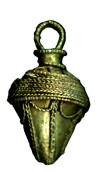Eneolithic flat axe from Raciborowice, site No. 7, Białopole commune, Chełm district
DOI:
https://doi.org/10.23858/SA/74.2022.2.3091Keywords:
early Eneolithic, coper flat axe, import, Lublin-Volhynian culture, eastern Lublin regionAbstract
This study is a contribution to research on copper metallurgy in the early Eneolithic (= Chalcolithic). The axe was discovered as a “single” artefact. It represents the category of flat axes with a convex cutting edge. The metallurgical mass consist of “pure” copper, or it may contain a small admixture of silver. The Raciborowice specimen corresponds well to the Szakálhát type, the Sárazsadány variant, and specifically to the two Budapest-Békásmegyer tools. According to Albert Schmitz’s classification, the tool from Raciborowice belongs to category 5 or to its variant marked as 6 (Beilform 5, 6). Categories 5 and 6 are dated to the early Eneolithic: from the transition of phase Ib to IIa, the entire phase II, up to phase IIIa. Their concentration occurs in Hungary and Slovakia, where are recorded in the Bodrogkeresztúr culture graves. The analysed artefact, should probably be related to the Lublin-Volhynian culture.
Downloads
References
Bronicki A. and Hander E. 2008. Wielokulturowe stanowisko 3 w Raciborowicach-Kolonii, pow. chełmski. In J. Libera (ed.), Pradziejowe i wczesnośredniowieczne materiały z Obniżenia Dubienki. Lubelskie Materiały Archeologiczne 16, 11-169 +2. Lublin: Wydawnictwo UMCS.
Brummack S. and Diaconescu D. 2014. A Bayesian approach to the AMS dates for the Copper Age in the Great Hungarian Plain. Prähistorische Zeitschrift 89/2, 242-260. DOI: https://doi.org/10.1515/pz-2014-0017
Chmielewski T. J. 2019. Chronologia absolutna rozwoju kręgu Polgár na etapie środkowego eneolitu (epoki miedzi). Gdańskie Studia Archeologiczne 7, 21-37.
Dobeš M. 1989. Zu den äneolithischen Kupferflachbeilen i Mähren, Böhmen, Polen und in der DDR – K eneolitickým plochym měděným sekerám na Moravě, v Čechách, Polsku a NDR. Praehistorica 15, 39-48.
Dobeš M. 2013. Měď v eneolitických Čechách Kupfer im Äneolithikum Böhmens (= Dissertationes Brunenses/Pragensesque 16). Praha: Filozofická Fakulta Univerzity Karlovy v Praze.
Gurba J. 1992. Siekierka miedziana z Wożuczyna w woj. zamojskim. Acta Universitatis Lodziensis. Folia Archaeologica 16, 71-74. DOI: https://doi.org/10.18778/0208-6034.16.09
Jacobs J. 1989. Jungsteinzeitliche Metallfunde aus Gebiet der DDR. Zeitschrift fűr Archaeologie 23, 1-17.
Kadrow S. 2016. About the Chronology of the Beginning of the Metal Ages. Analecta Archaeologica Ressoviensia 11, 66-78. DOI: https://doi.org/10.15584/anarres.2016.11.4
Kibbert K. 1980. Die Axte und Beile in mittleren Westdeutschland I (= Prähistorische Bronzefunde 9/10). München: C.H. Beck.
Klassen L., Dobeš M. and Pétrequin P. 2011. Dreieckige Kupferflachbeile aus Mitteldeutschland und Böhmen. Alt-Thüringen 41(2008/2009), 7-35.
Klochko V. I. and Kozymenko A.V. 2017. Drevniy metal Ukrainy. Kiev.
Kokowski A. and Jastrzębski S. 1983. Dokumentacja badań powierzchniowych obszaru 83-93. Lublin (typescript in Chełm Land Museum in Chełm).
Kuna M. 1981. Zur neolithischen und äneolithischen Kupferverarbeitung im Gebiet Jugoslawiens. Godišnjak 19, 13-81, I-XXVII.
Łęczycki S. 2010. Początki metalurgii oraz górnictwa od Anatolii po Europę Centralną. In P. P. Zagożdżon and M. Madziarz (eds), Dzieje górnictwa – element europejskiego dziedzictwa kultury 3. Wrocław: Oficyna Wydawnicza Politechniki Wrocławskiej, 205-240.
Masson V. M. and Merpert N. Ya. eds 1982. Eneolit SSSR. Moskva: Nauka.
Mayer: E. F. 1977. Die Äxte und Beile in Österreich (= Prähistorische Bronzefunde 9/9). München: C.H. Beck.
Miazga B. and Mozgała-Swacha M. 2018. Wyroby miedziane kultury jordanowskiej ze stan. 10/11/12 w Domasławiu, gm. Kobierzyce, w świetle badań metaloznawczych. Przegląd Archeologiczny 66, 31-43. DOI: https://doi.org/10.23858/PA66.2018.002
Mieczyński T. (ed.) ante 1939. Mapa gleb województwa lubelskiego/Soil map of the departament of Lublin 1: 300 000. Lublin: Wydział Gleboznawczy Instytutu w Puławach.
Novotna M. 1970. Die Äxte und Beile in der Slowakei (= Prähistorische Bronzefunde 9/3). München: C.H. Beck.
Patay P. 1984. Kupferzeitliche Maissel, Beile und Axte in Ungarn (= Prähistorische Bronzefunde 9/15). München: C.H. Beck.
Raczky P. and Siklósi Zs. 2013. Reconsideration of the Copper Age chronology of the eastern Carpathian Basin: a Bayesian approach. Antiquity 87, 555-573. DOI: https://doi.org/10.1017/S0003598X00049127
Říhovský J. 1992. Die Äxte, Beile, Meissel und Hämmer in Mähren (= Prähistorische Bronzefunde 9/17). Stuttgart: Franz Steiner.
Schmitz A. 2004. Typologische, chronologische und paläomatallurgische Untersuchungen zu den frühkupferzetlichen Kupferflachbeilen und Kupfermeißeln in Alteuropa. Dissertation zur Erlangung des akademischen Grades eines Doktors der Philosopfie der Philosophischen Fakultäten der Universität des Saarlandes 1/2 – Text, 2/2 – Anhang. Saarbrücken.
Szpunar A. 1987. Die Beile in Polen I (Flachbeile, Randleistenbeile, Randleistenmeißel) (= Prähistorische Bronzefunde 9/16). München: C.H. Beck.
Todorova H. 1981. Die kupferzeitlichen Äxte, und Beile in Bulgarien (= Prähistorische Bronzefunde 9/14). München: C. H. Beck.
Vandkilde H. 1996. From Stone to Bronze. The Metalwork of the Late Neolithic and earliest Bronze Age in Denmark (= Jutland Archaeological Society Publications 32). Højbjerg: Aarhus Universitetsforlag.
Vulpe A. 1975. Die Äxte und Beile in Rumänien II (= Prähistorische Bronzefunde 9/5). München: C. H. Beck.
Włodarczak P. 2006. Chronologia grupy południowo-wschodniej kultury pucharów lejkowatych w świetle dat radiowęglowych In J. Libera and K. Tunia (eds), Idea megalityczna w obrządku pogrzebowym kultury pucharów lejkowatych. Lublin, Kraków: Instytut Archeologii UMCS, Instytut Archeologii i Etnologii PAN, 27-66.
Zakościelna A. 2006. Kultura lubelsko-wołyńska. Zagadnienia jej genezy, periodyzacji i chronologii. In M. Kaczanowska (ed.), Dziedzictwo cywilizacji naddunajskich: Małopolska na przełomie epoki kamienia i miedzi (= Biblioteka Muzeum Archeologicznego w Krakowie 1). Kraków: Muzeum Archeologiczne w Krakowie, 77-94.
Zakościelna A. 2010. Studium obrządku pogrzebowego kultury lubelsko-wołyńskiej. Lublin: Wydawnictwo UMCS.
Žeravica Z. 1993. Die Äxte und Baile aus Dalmation und anderen Teilen Kroatien, Montenegro, Bosnien und Herzegowina (= Prähistorische Bronzefunde 9/18). München: Franz Steiner.
Downloads
Published
How to Cite
Issue
Section
License
Copyright (c) 2022 Sprawozdania Archeologiczne

This work is licensed under a Creative Commons Attribution 4.0 International License.














